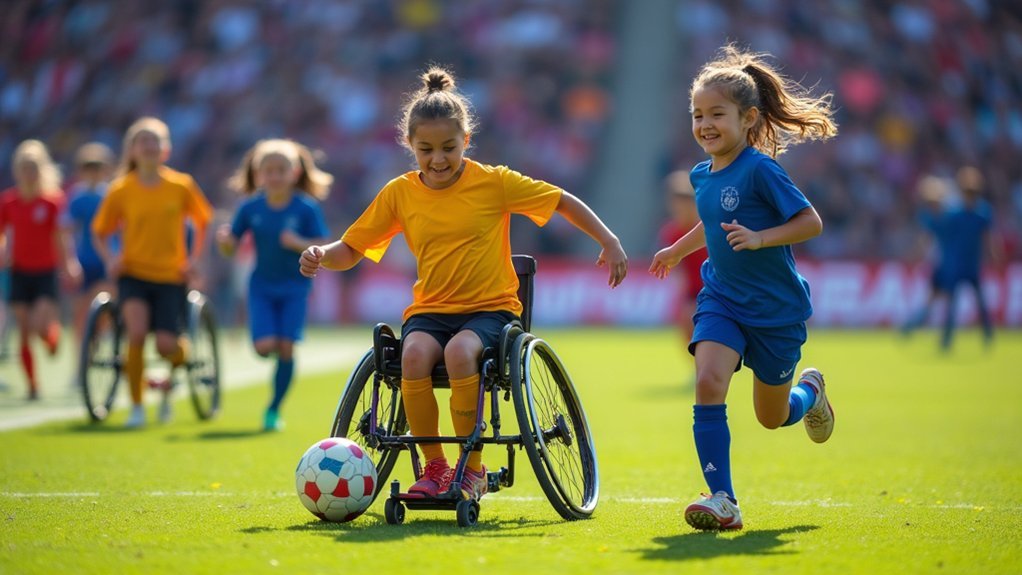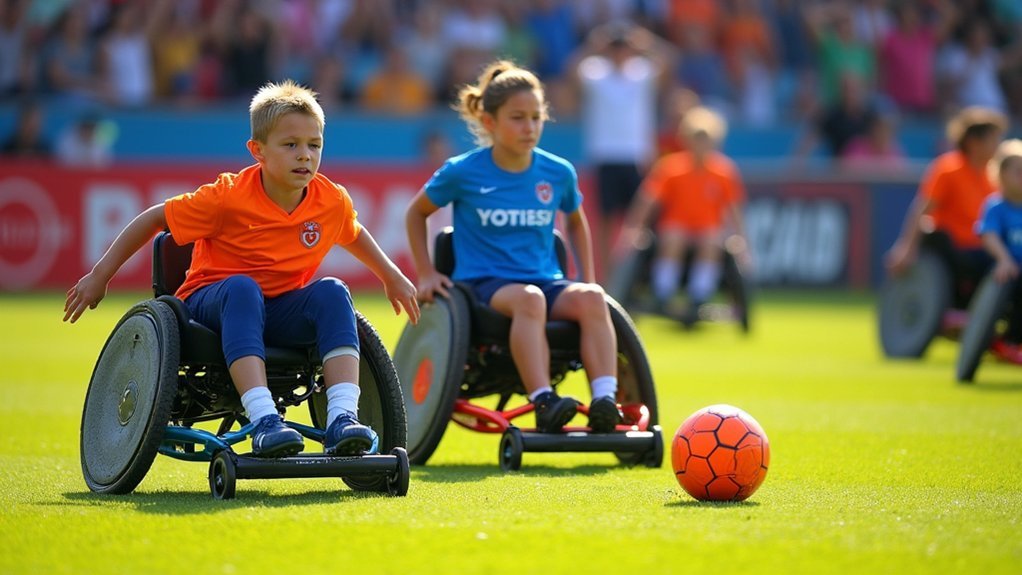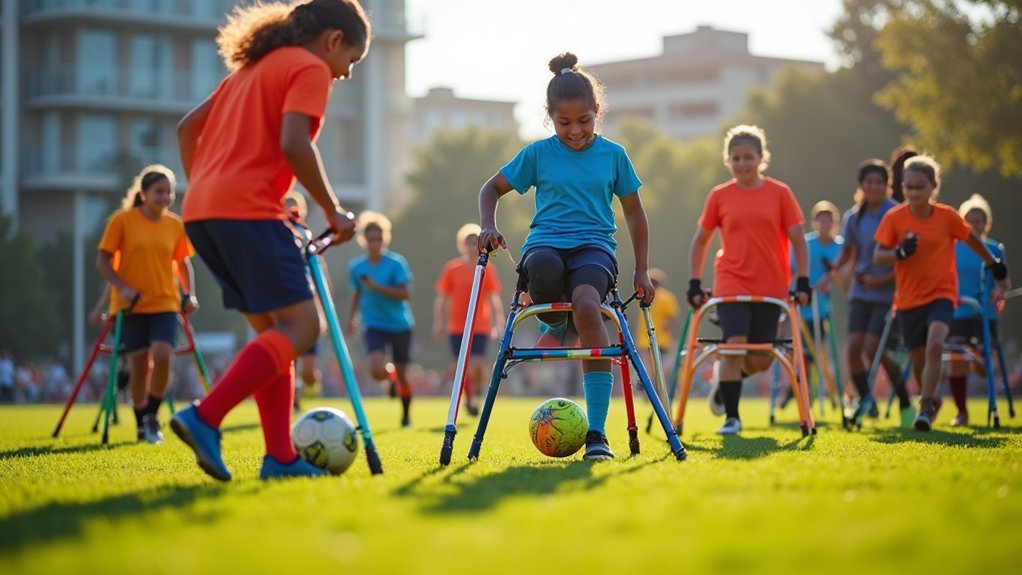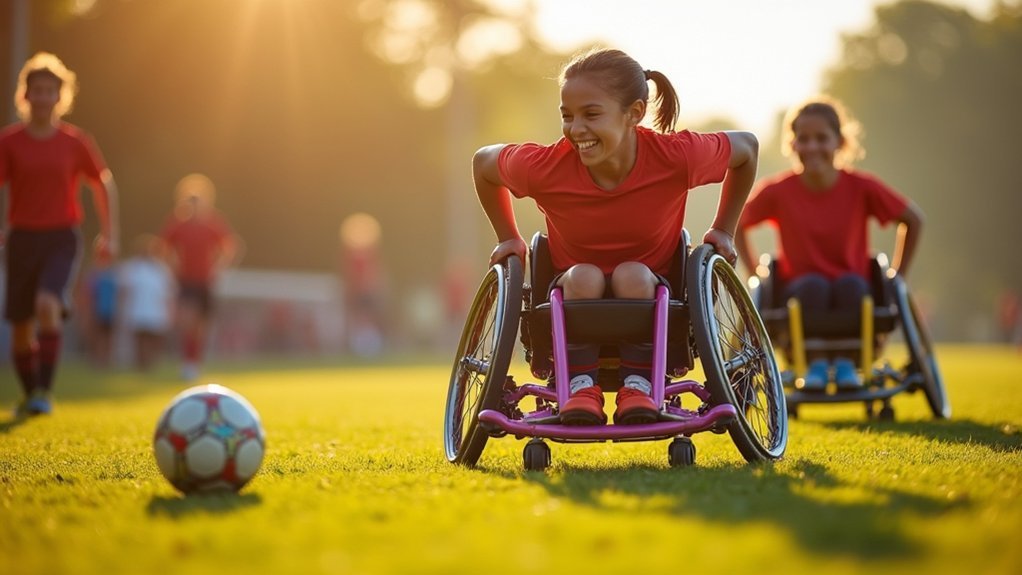For limited mobility, you can try power soccer using specialized wheelchairs with guards, frame soccer for walker/crutch users, or modified field dimensions for easier navigation. Smaller team formats (4v4 or 5v5) increase participation while specialized training focuses on hand-eye coordination rather than running. The two-on-one rule prevents crowding, and support buddies can assist players who need extra help. These adaptations offer physical, mental, and social benefits beyond traditional soccer experiences.
What Soccer Adaptations Work For Limited Mobility?

While traditional soccer might seem inaccessible to those with mobility limitations, power soccer offers an exciting alternative that’s specifically designed for wheelchair users.
You’ll find that this Adaptive Sport utilizes specialized power wheelchairs equipped with soccer guards that help you maneuver a larger, heavier ball effectively across the court.
Instead of grass fields, you’ll play on basketball courts, providing a flat, even surface that’s ideal for wheelchair navigation.
Basketball courts serve as the perfect playing surface for power soccer, eliminating terrain obstacles that might hinder wheelchair mobility.
The 13-inch, 2-pound ball enhances visibility and control for players. Custom wheelchairs and assistive devices enable athletes with various conditions like cerebral palsy and muscular dystrophy to participate competitively.
The rules are thoughtfully tailored with specific regulations on player proximity and movement, ensuring you’ll experience fair and inclusive gameplay regardless of your mobility challenges.
Understanding Different Mobility Limitations in Soccer Players
Because soccer adaptations must address diverse physical challenges, understanding the specific mobility limitations athletes face becomes essential for effective program development.
You’ll encounter players with conditions like cerebral palsy or muscular dystrophy, each requiring unique accommodations to participate successfully.
Athletes with disabilities often benefit from classification systems that group players by functional ability, ensuring fair competition and appropriate challenges. Some players may utilize power wheelchairs with specialized guards for ball control, while others might need modified rules allowing additional time for movement on the field.
When developing adaptive soccer programs, you must consider the range of mobility limitations present—from temporary injuries to permanent conditions—and implement appropriate equipment and rule modifications that maintain the sport’s competitive nature while maximizing participation opportunities.
Power Soccer: The Ultimate Wheelchair Adaptation

Power soccer transforms conventional play through specialized wheelchairs fitted with guards that allow you to strike a custom 13-inch ball with precision and power.
You’ll discover unique team dynamics where positioning and timing replace running and jumping, creating strategic depth that’s both challenging and rewarding.
Whether you have MS, cerebral palsy, or quadriplegia, this basketball court adaptation offers competitive opportunities from local leagues to the World Cup stage, making elite athletics accessible regardless of mobility limitations.
Specialized Wheelchair Equipment
At the forefront of adaptive sports technology, Strike Force power wheelchairs represent the cornerstone of competitive power soccer. These chairs are specifically customized to match each athlete’s unique disability, providing maximum mobility and control during intense gameplay.
Individuals with disabilities rely on these specialized chairs to compete effectively on the court.
Your power soccer wheelchair comes equipped with soccer guards, essential attachments that serve dual purposes: they protect you during collisions and enable precise ball handling.
The sport utilizes a 13-inch diameter ball weighing approximately 2 pounds—significantly larger and heavier than traditional soccer balls. This specialized equipment design guarantees better visibility and control for players with limited mobility, allowing you to maneuver effectively on the basketball court surface used in official competitions.
Team Strategy Dynamics
While traditional soccer revolves around footwork, power soccer transforms this dynamic entirely through sophisticated team strategies adapted for wheelchair mobility.
You’ll notice power soccer athletes employ unique positioning principles, particularly with the two-on-one rule that prevents crowding and promotes strategic spacing on the court.
Team strategy dynamics center around the four-player formation, with specific defensive limitations allowing only two players plus the goalie to defend simultaneously.
This creates opportunities for offensive creativity and tactical positioning. The larger 13-inch ball demands coordinated movements and precise passing sequences between teammates.
Communication becomes essential as you coordinate attacks and defensive formations with your fellow power soccer athletes.
Success depends less on individual speed and more on collaborative positioning, anticipatory movements, and synchronized team maneuvers to outthink opponents and create scoring opportunities.
Accessibility Benefits
Unlike conventional sports that often exclude individuals with mobility limitations, power soccer opens doors to athletic competition through purposeful wheelchair adaptations.
You’ll find this sport specifically designed with accessibility at its core, played on flat basketball courts that accommodate power wheelchairs equipped with specialized guards.
The game welcomes participants with various disabilities including multiple sclerosis, quadriplegia, and cerebral palsy.
Its modified equipment—like the larger 13-inch diameter ball—enhances visibility and control for players with limited mobility.
Beyond physical activity, power soccer fosters social connections through regular competitions, including the quadrennial World Cup.
These thoughtful adaptations transform what was once inaccessible into an engaging athletic opportunity, proving that competitive sports can be reimagined to include everyone regardless of mobility challenges.
Frame Soccer for Walker and Crutch Users

Since its inception in England in 2014, Frame Soccer has transformed the sporting landscape for individuals who use walkers and crutches. This innovative adaptation allows players with limited mobility to experience the joy and benefits of soccer through thoughtfully modified rules and equipment.
In Frame Soccer, athletes use specialized supportive frames that provide stability while enabling movement and ball control during gameplay. These frames serve as both mobility aids and playing tools, letting participants maneuver across the field with confidence.
The sport emphasizes teamwork and skill development in an inclusive environment. Regular competitions give players opportunities to showcase their abilities while raising awareness about adaptive sports.
You’ll find that Frame Soccer delivers both physical activity benefits and valuable social connections for participants.
Modified Field Dimensions and Playing Surfaces
Because not all players can navigate traditional soccer pitches, adaptive soccer embraces modified field dimensions that accommodate various mobility limitations.
You’ll find smaller field sizes tailored specifically for athletes with limited mobility, creating spaces where maneuverability becomes easier and more engaging.
Power soccer, for instance, utilizes basketball courts rather than grass fields.
Power wheelchair athletes thrive on smooth basketball courts where precision movements replace traditional field navigation.
This flat, level surface provides ideal conditions for power wheelchair users who need consistent terrain for effective play.
The specialized dimensions complement adaptive equipment like larger balls, allowing players to showcase their skills despite mobility challenges.
Specialized Equipment and Adaptive Gear Options
If you’re interested in power soccer, you’ll need a specialized wheelchair with custom configurations that enhance turning radius and acceleration capabilities.
Your chair can be equipped with innovative attachments like the Strike Force soccer guard, which wraps around the front of your wheelchair to control the 13-inch ball effectively.
These adaptive solutions allow you to participate fully in the sport, maintaining proper distance from other players while maximizing your ability to maneuver on the court.
Power Wheelchair Configurations
Specialized power wheelchairs serve as the cornerstone of competitive power soccer, with the Strike Force model standing as the premier choice for serious athletes.
You’ll find these chairs equipped with essential soccer guards that protect both players and equipment while allowing effective ball handling during matches.
Each power wheelchair can be customized to accommodate your specific disability needs, optimizing your performance and comfort on the court.
While Blind Athletes benefit from different adaptations, power soccer players require precise wheelchair configurations to navigate the 13-inch, 2-pound ball used in competition.
Your wheelchair becomes an extension of your body, enabling you to dribble, pass, and shoot with precision despite mobility limitations.
These tactical configurations transform standard mobility aids into competitive sports equipment, leveling the playing field for all participants.
Attachment Innovation Solutions
Power wheelchairs represent just the beginning of adaptive soccer equipment. Specialized attachments transform mobility aids into effective soccer gear, creating opportunities for athletes with limited mobility to compete confidently.
The Strike Force model exemplifies these adaptations, featuring customized soccer guards that enhance ball control during power soccer matches.
Your options for adaptive equipment include:
- Soccer guards that attach to wheelchairs for improved ball handling and protection
- Frame attachments for walkers and crutches enabling participation in frame soccer
- Larger, heavier 13-inch soccer balls (approximately 2 pounds) for better visibility and control
These innovations extend beyond wheelchairs to accommodate various mobility aids.
Sound systems and vocal cues further enhance accessibility, particularly for visually impaired players. With these adaptations, power soccer becomes accessible to athletes with diverse mobility requirements.
Rule Modifications That Enhance Participation
When traditional soccer rules meet the needs of athletes with limited mobility, a new dimension of inclusive sport emerges. Power soccer transforms standard gameplay through strategic rule modifications that maximize participation and competitive balance.
Players must adhere to the two-on-one proximity rule, which prevents crowding by allowing only one defender within three meters of an opponent. This creates more space for attacking plays and tactical decision-making.
Additionally, defensive positioning is regulated—only two players (excluding the goalie) can defend the goal simultaneously.
The game moves from grass fields to basketball courts, providing a consistent surface for power wheelchairs. The 13-inch, 2-pound ball accommodates players with limited upper body strength, while specialized soccer guards on wheelchairs enable effective ball control without equipment damage.
Team Size Adjustments for Maximizing Engagement
Beyond rule adaptations, thoughtful team size configuration plays a key role in creating meaningful soccer experiences for athletes with limited mobility.
Smaller team sizes markedly increase player involvement, allowing participants more opportunities to touch the ball and develop their skills. Programs like U.S. Youth Soccer TOPSoccer and power soccer have embraced this approach with excellent results.
When you’re organizing adaptive soccer, consider these team size benefits:
- Formats like 4v4 or 5v5 provide more active participation for each player
- Smaller teams foster better communication and teamwork among athletes
- Reduced waiting periods guarantee everyone gets substantial playing time
Training Techniques for Players With Mobility Challenges
Developing effective training techniques requires specialized approaches for athletes with mobility challenges. You’ll find that Strike Force power chairs greatly enhance player maneuverability during practices, giving athletes greater control on the field.
Focus your drills on hand-eye coordination and spatial awareness to help players improve passing and shooting skills while using adapted wheelchairs. Conduct small-sided games on basketball courts, which provide level surfaces and controlled environments accommodating specific mobility needs.
For visually impaired players, implement vocal cues and sound systems to assist with orientation and gameplay improvement.
Remember to regularly reassess your training techniques to guarantee they effectively address each athlete’s specific mobility challenges.
These adaptations will promote skill development, confidence, and meaningful participation for all players regardless of their mobility limitations.
The Role of Support Players and “Buddies” in Adaptive Soccer
Support players and “buddies” serve as the backbone of successful adaptive soccer programs, creating bridges that connect athletes with mobility challenges to the full soccer experience. In programs like AYSO VIP and TOPSoccer, these trained volunteers provide essential assistance that transforms how players with disabilities engage with the sport.
The impact of support players in adaptive soccer extends beyond physical assistance:
- They facilitate communication between teammates, helping everyone understand roles and expectations.
- They foster meaningful social connections that build confidence and create a sense of belonging.
- They increase participation rates by addressing barriers to entry and ensuring everyone can contribute regardless of mobility limitations.
You’ll find these buddy systems create environments where friendships flourish alongside athletic development.
Successful Adaptive Soccer Programs Around the World
The global landscape of adaptive soccer has flourished in recent years, showcasing powerful models of inclusion and innovation.
The U.S. National Amputee Soccer Team’s World Cup qualification marks a significant milestone after years of dedicated development. Meanwhile, Power Soccer offers wheelchair users with severe mobility limitations an opportunity to compete using specialized equipment.
For visually impaired athletes, Blind Soccer under IBSA governance employs noise-making balls to create an accessible version of the sport. The DAAA has established Dwarf Soccer competitions specifically tailored for athletes of short stature, expanding participation opportunities.
The AYSO VIP program demonstrates how community engagement enhances adaptive soccer programs through buddy systems that pair children with disabilities with supportive teammates, creating an inclusive environment where players of all abilities can experience the joy of competition.
Mental and Physical Benefits of Adapted Soccer Participation
When you join an adapted soccer program, you’ll experience significant improvements in your cardiovascular health, muscle strength, and coordination despite mobility limitations.
You’ll likely notice enhanced mental wellness as team participation reduces isolation and depression while fostering meaningful social connections with teammates who share similar challenges.
Your cognitive function and memory may also improve with regular participation, complemented by increased self-confidence and motivation that extends into other areas of your life.
Mental Health Advantages
Beyond physical improvements, adapted soccer serves as a powerful catalyst for mental wellness among athletes with limited mobility. When you participate in adapted soccer, you’ll experience significant reductions in anxiety and depression while developing stronger social connections that combat isolation.
The mental health benefits extend beyond the playing field:
- You’ll enjoy enhanced cognitive function and memory retention, giving you improved focus for daily activities.
- Your self-esteem will flourish through teamwork and camaraderie, empowering you to tackle new challenges.
- You’ll develop effective stress management skills as physical activity naturally boosts your mood.
These psychological advantages make adapted soccer more than just a game—it’s a thorough approach to wellbeing that nurtures your mind while engaging your body.
Physical Wellness Improvements
Energy surges through every adapted soccer player as regular participation triggers multiple physical wellness benefits.
You’ll experience improved cardiovascular health while reducing obesity risks through consistent exercise in programs like power soccer. These adaptations aren’t just games—they’re structured physical activities that develop your muscle strength and coordination.
With each practice and match, you’re enhancing your mobility and daily functioning capabilities. Your body responds to these challenges by building endurance and flexibility that transfer directly to everyday activities.
Studies confirm that players with limited mobility develop sharper cognitive function and better memory through regular participation in adapted soccer. The physical demands of the sport stimulate multiple body systems simultaneously, creating extensive wellness improvements that extend far beyond the playing field.
Frequently Asked Questions
How Do People With Disabilities Play Soccer?
You can play soccer with limited mobility through Power Soccer (using specialized wheelchairs), Blind Soccer (with noise-making balls), and Frame Soccer (using walkers or crutches). These adaptations enable you to participate despite physical challenges.
How to Improve Flexibility for Soccer?
You’ll improve flexibility for soccer by incorporating dynamic stretches before practice, static stretches afterward, and regular yoga sessions. Don’t forget to use foam rollers to release muscle tightness and enhance your range of motion.
What Is Adaptive Soccer?
Adaptive soccer is a modified version of traditional soccer that you’ll find specially designed for players with disabilities. It includes variations like power soccer, where you’ll use specialized wheelchairs to play competitively.
How to Stop Being Stiff While Playing Soccer?
To stop feeling stiff while playing soccer, you’ll benefit from regular dynamic warm-ups, targeted stretching routines, proper hydration, and cross-training with activities like yoga or swimming that enhance your overall flexibility and muscle elasticity.
In Summary
Soccer’s adaptability offers something for everyone, regardless of mobility challenges. You’ve seen how power soccer, frame soccer, modified playing surfaces, and supportive training methods can transform the beautiful game. Whether you’re playing from a wheelchair or using a walker, these adaptations don’t just make participation possible—they make it meaningful. By embracing these inclusive approaches, you’ll discover the joy, community, and confidence that adapted soccer provides.





Leave a Reply